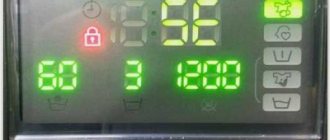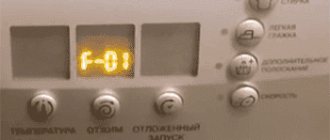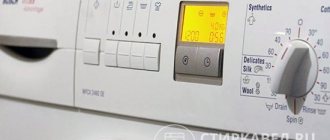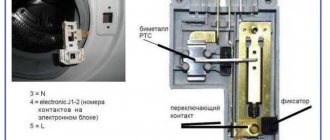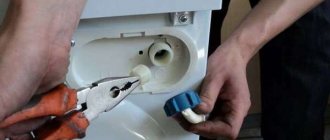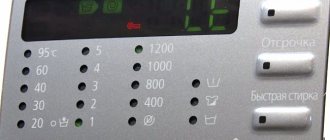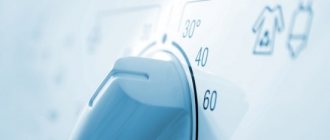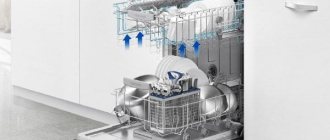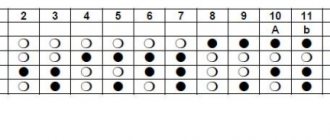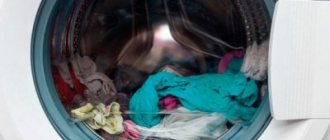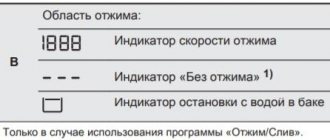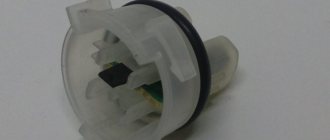Many modern washing machines, including those produced by the famous German brand AEG, are equipped with a self-diagnosis program: if problems occur, error codes are displayed on the display. This is very convenient, as it allows you to reduce the time required to find a fault.
The most common error codes include E20, which indicates that waste water is not being drained from the tank. Such a failure leads to the machine “freezing” in the middle of the cycle, because it simply cannot draw clean water for rinsing. In some models of AEG washing machines, alternatives to code E20 are EF0 and C2. 2 beeps may also sound.
The article will discuss the main causes of error E20 and how to eliminate it.
Clogged drain filter
This is the most common reason for the appearance of the E20 code in the absence of regular maintenance of the AEG washing machine. But before diagnosing a blockage in the filter, you should perform a simple manipulation by resetting the current program by disconnecting the device from the network. If after turning on and starting the drain again the error does not disappear, it is recommended to check the drain filter.
In AEG washing machines it is located in the lower right corner of the case. Carefully remove the part, rinse it under running water and install it back.
Error interpretation
Code E20 in the AEG washing machine informs the user that there is no drain. In other words, for some reason the AEG brand washing machine cannot get rid of the waste water that remains in the tank after washing. Accordingly, she also cannot continue to execute the washing program, since there is simply nowhere to get clean water. This problem may be caused by the following reasons:
- clogged drain filter;
- pump malfunction;
- kinked drain hose.
This error should not be confused with error E21, they are of course similar. However, error E21 indicates a wider range of problems associated with draining waste water from the tank. The presence of errors E20 and E21 greatly facilitates the work of the technician, since they limit the range of reasons why there is no drain. Accordingly, the technician will not have to check a bunch of parts before he discovers the weak point that caused the specified error.
Alternative codes
There are several dozen models of cars of this brand, produced at different times. Their diagnostic system is slightly different. More precisely, the error codes of AEG washing machines differ. In some washing machines, alternatives to code E20 are codes C2 and EF0. You will also hear two beeps. They also indicate a blockage in the drain system.
For your information! On some models, the EF0 code also indicates increased foaming.
Let's not get distracted and return to the specific error E20, what should we do with it?
Removing blockages
First, try resetting the program by unplugging the washing machine from the network. This is the most universal way to stop one program and start a new one after reconnecting the washing machine to the network. Then turn on the machine and try to start draining. If the reset did not help and the error appears again or the machine freezes, then proceed to checking the drain filter. For an AEG washing machine it is located in the lower right corner. Open the door and unscrew the part. Then we wash it and return it to its place.
Drain pump malfunction
If the problem is not in the filter, the drain pump (pump) may have failed. In this case, you need to replace the part by first reading the simple instructions and purchasing a new spare part for a specific model of the AEG washing machine. The process of replacing the drain pump is as follows:
- The equipment is disconnected from the network, water supply and sewerage systems.
- The top cover of the device is removed (you need to unscrew the screws and move it horizontally, and then remove it).
- The detergent container is removed.
- The screws located under the container are unscrewed (they secure the entire front part of the equipment).
- The control panel snaps off and is placed on the machine without disconnecting the wires.
- Another row of screws under the panel is unscrewed.
- The hatch door is opened, the metal clamp is removed from the cuff, and then the water inlet pipe is removed.
- The cuff is removed from the groove in the front wall and tucked into the drum.
- The wires are disconnected from the door lock.
- The drain filter is pulled out.
- The screws are removed from the bottom of the device.
- The front part of the body moves away.
- The pipes and all wires are disconnected from the pump, the pump itself is unscrewed and removed from the washing machine.
- A new part is installed and the device is assembled.
Error codes for AEG washing machines
The manufacturer of washing machines AEG has taken care not only of reliable and convenient washing of various types of items, but also of making its use and maintenance as simple as possible.
To do this, the machine has a built-in self-diagnosis system, which identifies all faults that have arisen and makes it possible to quickly eliminate them. Errors in the AEG washing machine are displayed on the displays. Knowing the meaning of the displayed codes will reduce the cost and time of necessary repairs. Use your machine carefully and it will serve you for a long time without breakdowns.
INSTRUCTIONS FOR AEG WASHING MACHINES
Next, let's look at the error codes of AEG washing machines and their interpretation, which is necessary to identify a breakdown:
| Error code | Description of the error | Causes and elimination |
| E11 | There is no water filling during the wash cycle (the water level in the tank was not reached within the allotted time) |
|
| E13 | There is a water leak in the washing machine pan |
|
| E21 | Water has not been drained from the tank within 10 minutes |
|
| E23 | The control triac of the drain pump is faulty (located on the electronic controller) |
|
| E24 | Defect in the drain pump triac control circuit (its elements, like the triac, are located on the electronic controller) |
|
| E31 | Pressure sensor malfunction | The frequency of the pressure sensor is outside the permissible limits, there is a break in the electrical wiring.
|
| E32 | Pressure sensor calibration problems | After initial calibration, the water level is outside the range of 0-66 mm and the anti-boil level has not been reached.
|
| E33 | Inconsistency in the operation of water level sensors (the sensor protecting the heating element from turning on the latter without water and the first level sensor) | The most likely causes of such an error may be:
|
| E34 | Inconsistency between the pressure switch and the anti-boil level (2) | The error has existed for more than 60 seconds.
|
| E35 | The water level in the tank is higher than permissible | During the filling process, the so-called overflow level was reached (the overflow level switch was open for more than 15 seconds)
|
| E36 | The protection level sensor of the heating element (AV S) is faulty |
|
| E37 | Malfunction of the first water level sensor (L1 S) |
|
| E38 | The pressure switch tube is clogged
|
|
| E39 | Malfunction of the overflow level sensor (HV1 S) |
|
| E3A | Heating element relay malfunction |
|
| E41 | The hatch is open or not closed tightly | |
| E42 | The hatch lock is faulty |
|
| E43 | The control triac (located on the electronic controller) of the hatch lock is faulty |
|
| E44 | The sunroof closing sensor is faulty |
|
| E45 | The elements of the hatch lock triac control circuit are faulty (its elements, like the triac, are located on the electronic controller) |
|
| E51 | Short circuit in the control triac of the drive motor (located on the electronic controller) |
|
| E52 | The signal from the tachogenerator of the drive motor is sent to the electronic controller |
|
| E53 | The elements of the drive motor triac control circuit are faulty (its elements, like the triac, are located on the electronic controller) |
|
| E54 | “Sticking” of one of the contact groups of the reverse relay (there are two in total) of the drive motor (the relays are located on the electronic controller) |
|
| E55 | Open circuit in the engine |
|
| E56 | No signal from the tachometer generatorNo signal after 15 minutes |
|
| E57 | The current exceeds the threshold value >15A |
|
| E58 | Motor phase current exceeds threshold value >4.5A |
|
| E59 | After setting a new rotation speed other than zero, there is no tachometer signal for 3 seconds |
|
| E5A | The temperature of the cooling radiator exceeds the threshold value (88°C) |
|
| E5B | DC bus voltage drops below threshold (430V) |
|
| E5D | FCV cannot receive and/or send a message within 2 seconds |
|
| E5E | Communication error between FCV control board and main PCB |
|
| E5F | FCV control board continuously requests configuration parameters due to repeated resets |
|
| E61 | When heating water, its temperature does not reach the set value within a certain time | ! This code is not available for reading in the normal operating mode of the SM - it is displayed only in diagnostic mode.
|
| E62 | While heating the water, its temperature reached more than 88°C in 5 minutes |
|
| E66 | The heating element relay is faulty |
|
| E68 | The leakage current in the washing machine is too high |
|
| E71 | The resistance of the temperature sensor is outside the specified limits |
|
| E74 | NTC (temperature sensor) in wrong position in tank |
|
| E82 | Error selector position selection |
|
| E83 | Error reading data from the selector (this code can only be read in diagnostic mode) |
|
| E84 | Recirculation pump recognition errorInput voltage is always 0V or 5V |
|
| E85 | Recirculation pump malfunction Thyristor malfunction |
|
| E91 | Communication error between user interface and main unit |
|
| E92 | Mismatch between user interface and main unit |
|
| E93 | SM configuration error |
|
| E94 | CM and cycle (program) configuration errors |
|
| E95 | Communication error between the processor and non-volatile memory located on the electronic controller |
|
| E96 | Mismatch between the configuration of the electronic controller and the external elements that are connected to it (or not) |
|
| E97 | Inconsistency in the operation of the program selector and the software of the electronic controller |
|
| E98 | Mismatch between the engine control unit and the main electronics |
|
| E99 | Abnormal connection between the sound unit and the input/output electronics |
|
| E9A | The hardware/software between the speaker and the input/output electronics is faulty |
|
| EA1 | DSP system malfunction |
|
| EA2 | DSP recognition error | |
| EA3 | DSP cannot lock motor pulley |
|
| EA4 | DSP fault |
|
| EA5 | DSP thyristor fault | |
| EA6 | There is no signal about drum rotation during the first 30 seconds |
|
| EB1 | The frequency of the supply network does not correspond to the permissible |
|
| EB2 | The supply voltage is above the permissible limit |
|
| EB3 | The supply voltage is below the permissible limit |
|
| EBE | Safety circuit relay fault |
|
| EBF | Protection circuit recognition error |
|
| EC1 | Fill valve blocked |
|
| EC2 | Malfunction of the water transparency sensor (if equipped) |
|
| EF1 | Filter clogged Drain hose clogged Drain time too long |
|
| EF2 | Overdosage of detergent, very strong foam during drainage Filter clogged Drain hose clogged |
|
| EF3 | The Aqua Control system is on. The drain pump cable is faulty. There is a break in the drain pump. There is a water leak in the machine. |
|
| EF4 | There is no signal from the flow sensor when the filling valves are turned on |
|
| EF5 | Spin cycle interrupted, unbalance too large >1200g |
|
| EH1 | The supply voltage frequency is outside the permissible limits |
|
| EH2 | Supply voltage too high Incorrect power supply |
|
| EH3 | Supply voltage too low. Unsuitable power supply or network interference. | |
| EHE | Safety circuit relay fault |
|
| EHF | Protection circuit recognition error |
|
How to protect your machine from error E20
Of course, when you buy a washing machine from AEG, you are probably interested in its long service life, as well as early warning of malfunctions. As a rule, the appearance of error code E20 in AEG washing machines is associated with long-term operation and lack of regular preventive maintenance: for example, the same drain filter should be cleaned at least once a year.
As for the failure of the pump (drain pump), this malfunction often occurs due to voltage fluctuations in the electrical network, as well as poor quality of tap water. By the way, the second factor negatively affects many elements of equipment, disabling them, in particular heating elements. Therefore, you can often extend the life of your AEG machine and prevent the appearance of the E20 code simply by purifying the water used by the washing and rinsing equipment.
What to do if code E20 occurs?
If error E20 appears on the display, you should call a technician who specializes in repairing washing machines. If the owner of the equipment is confident in his abilities or has the knowledge, you can try to independently identify and try to correct the cause of the malfunction.
To do this, you need to inspect the details of the equipment. Algorithm of actions, following which you can identify a breakdown:
- Disconnect the equipment.
- Drain the water remaining in the tank through the hose, having first unscrewed it from the sewer outlet.
- If the water flows out easily, then the problem is that the pump or sewer is clogged (it is worth cleaning the siphon).
- Now you can get the laundry.
- If there is no blockage, it is worth checking the filter and drain pump.
- To inspect the filter, you need to unscrew it, pull it out and wash it.
- To assess the condition of the pump (pump), it is necessary to separate it from the machine by disconnecting the pipe from the tank.
- Unscrew the cap on the pump and inspect the impeller.
- To check the pump with a multimeter, you need to attach the probes of the device to the part and record the resistance value.
- Rinse the pipe, clean the drain hose with a cleaning cable.
To confirm that the fault has been eliminated, you should run the equipment in test mode and check the functioning of the pressure switch and wiring. If everything works properly, then the electronic module is tested last. If a module breaks down, it is usually not repaired, but replaced with a new one.
Tap water purification products
Existing methods for purifying tap water from metal salts, rust, sand and other small impurities can be divided into two large groups: mechanical and chemical.
Mechanical methods are based on the use of special mesh filters with very small cells. They remove only mechanical impurities from tap water: rust, clay, sand. The degree of purification depends on the size of the cells. The filters themselves can be non-washing or self-washing. Most often they are used for preliminary (rough) cleaning.
Chemical methods involve the use of various minerals (shungite, silicon) and sorbents (resins, activated carbon). They remove heavy metal salts, fluorine, chlorine and organic matter from water. The number of purification steps and the type of reagents used directly affect the specific list of substances to be removed.
